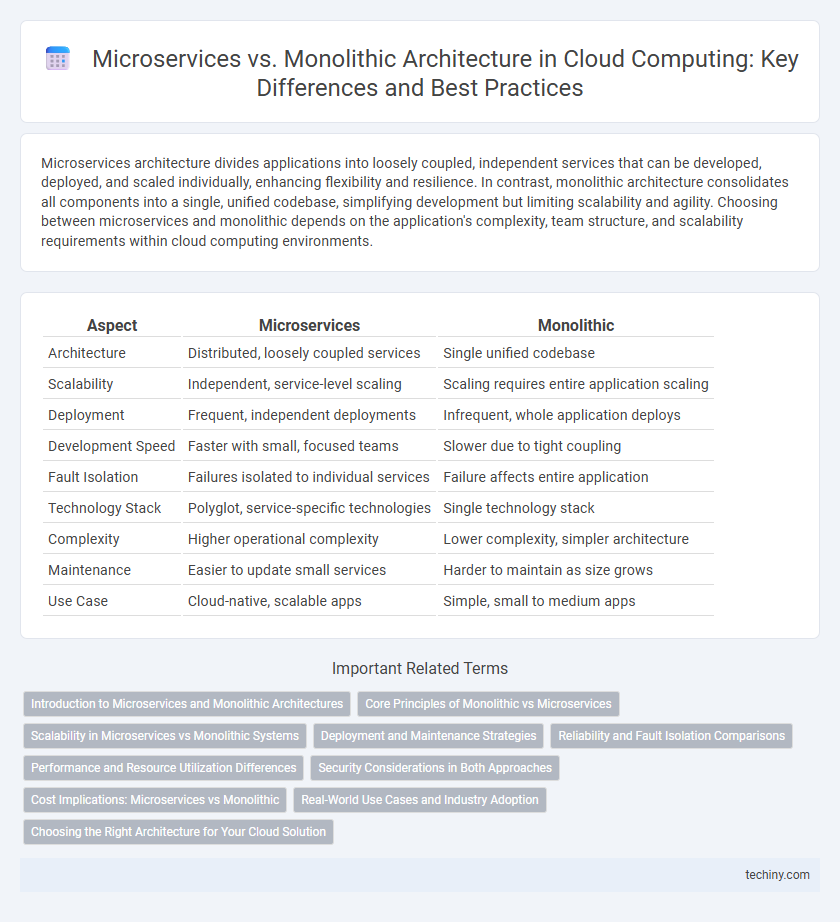Microservices architecture divides applications into loosely coupled, independent services that can be developed, deployed, and scaled individually, enhancing flexibility and resilience. In contrast, monolithic architecture consolidates all components into a single, unified codebase, simplifying development but limiting scalability and agility. Choosing between microservices and monolithic depends on the application's complexity, team structure, and scalability requirements within cloud computing environments.
Table of Comparison
| Aspect | Microservices | Monolithic |
|---|---|---|
| Architecture | Distributed, loosely coupled services | Single unified codebase |
| Scalability | Independent, service-level scaling | Scaling requires entire application scaling |
| Deployment | Frequent, independent deployments | Infrequent, whole application deploys |
| Development Speed | Faster with small, focused teams | Slower due to tight coupling |
| Fault Isolation | Failures isolated to individual services | Failure affects entire application |
| Technology Stack | Polyglot, service-specific technologies | Single technology stack |
| Complexity | Higher operational complexity | Lower complexity, simpler architecture |
| Maintenance | Easier to update small services | Harder to maintain as size grows |
| Use Case | Cloud-native, scalable apps | Simple, small to medium apps |
Introduction to Microservices and Monolithic Architectures
Microservices architecture breaks down applications into small, independent services that communicate through APIs, enabling scalability and faster deployment. Monolithic architecture consolidates all components into a single, unified codebase, simplifying development but limiting flexibility and scalability. Understanding these foundational differences guides organizations in choosing the optimal approach for cloud-native application design.
Core Principles of Monolithic vs Microservices
Monolithic architecture centralizes all components into a single unified codebase, emphasizing simplicity in deployment and tight coupling of services. Microservices break down applications into independently deployable, loosely coupled services, each responsible for a specific business capability, promoting scalability and flexibility. Core principles of microservices include decentralized data management and continuous integration, contrasting with the monolithic focus on a single database and a unified deployment pipeline.
Scalability in Microservices vs Monolithic Systems
Microservices architecture enhances scalability by enabling independent scaling of individual services based on demand, whereas monolithic systems require scaling the entire application, often leading to inefficient resource use. Distributed deployment in microservices allows dynamic allocation of resources, optimizing performance during varying workloads. Monolithic systems typically encounter scalability bottlenecks due to tightly coupled components that hinder flexibility and rapid response to traffic spikes.
Deployment and Maintenance Strategies
Microservices architecture enables independent deployment and scaling of individual services, reducing system downtime and facilitating continuous integration and delivery. In contrast, monolithic applications require redeploying the entire system for updates, increasing the risk of deployment failures and slowing release cycles. Maintenance in microservices benefits from isolated debugging and quicker fault isolation, whereas monolithic maintenance often involves complex codebase management and longer testing phases.
Reliability and Fault Isolation Comparisons
Microservices architecture enhances reliability by isolating faults within individual services, preventing system-wide failures common in monolithic applications. Monolithic systems face higher risk when a single component fails, potentially causing entire application downtime. Fault isolation in microservices improves maintainability and uptime by allowing independent updates and faster recovery from errors.
Performance and Resource Utilization Differences
Microservices architecture enables better performance optimization by allowing independent scaling of components, improving resource utilization through containerization and efficient load distribution. Monolithic systems often face performance bottlenecks due to tightly coupled components and limited scalability, resulting in higher resource consumption under heavy loads. Cloud environments enhance microservices by dynamically allocating resources based on real-time demand, leading to improved responsiveness and cost efficiency.
Security Considerations in Both Approaches
Microservices architecture enhances security by isolating services, reducing the attack surface, and enabling fine-grained access controls, though it requires robust inter-service authentication and network security measures. Monolithic applications centralize security management, simplifying enforcement but increasing risk since a single vulnerability can compromise the entire system. Effective security in microservices demands strong API gateways, container security, and comprehensive monitoring, whereas monolithic security relies heavily on perimeter defenses and integrated access control frameworks.
Cost Implications: Microservices vs Monolithic
Microservices architecture often incurs higher initial costs due to the complexity of managing multiple services and the need for advanced orchestration tools, whereas monolithic applications typically have lower upfront expenses with simpler deployment. Over time, microservices can reduce costs by enabling independent scaling, targeted resource allocation, and faster feature deployment, which improves operational efficiency. Monolithic systems may face escalating maintenance costs as the codebase grows and scaling requires duplicating the entire application stack.
Real-World Use Cases and Industry Adoption
Microservices architecture enables Netflix and Amazon to achieve rapid deployment, scalability, and resilience by decomposing applications into loosely coupled services, contrasting with traditional monolithic systems used by legacy enterprises. Financial institutions like JPMorgan Chase adopt microservices to enhance transaction processing speed and fault isolation, while small businesses may prefer monolithic designs for simplicity and cost-efficiency. Industry adoption trends indicate microservices dominate cloud-native development, driving agility in sectors like e-commerce, healthcare, and telecommunications, whereas monolithic architectures persist in stable, less complex environments.
Choosing the Right Architecture for Your Cloud Solution
Choosing the right architecture for your cloud solution depends on factors such as scalability, development speed, and maintenance complexity. Microservices architecture offers enhanced scalability and independent deployment, ideal for large, dynamic applications with frequent updates. Monolithic architecture suits simpler, smaller projects with straightforward deployment and easier initial development, but may hinder scalability and flexibility in growing cloud environments.
Microservices vs Monolithic Infographic

 techiny.com
techiny.com